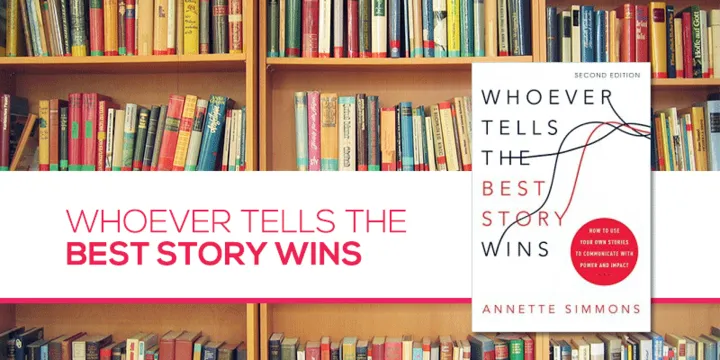Six types of storytelling: how entrepreneurs and leaders can deliver inspiration and impact
Storytelling is a powerful communications tool, and it is becoming more and more recognised in the business community. These stories go beyond speech openers or ice breakers, and are a good technique in addition to the usual rational, objective and linear corporate presentations.
Stories about end-users are already integrated into disciplines like design thinking. Entrepreneurs and leaders can effectively use stories for internal, organisational and external change, via online and offline channels.

“Technology dumps so much information on us. We now need a new conscious process to translate that information back into the human brain’s inborn format for understanding the world: into story,” begins management consultant Annette Simmons in her new book.
The 2015 edition of her bestseller, ‘Whoever Tells the Best Story Wins: how to use your own stories to communicate with power and impact,’ offers useful tips in storythinking, classifies stories into six types, and describes the art of cultivating good stories. Her three other books include ‘The Story Factor,’ ‘A Safe Place for Dangerous Truth’ and ‘Territorial Games: Understanding and Ending Turf Wars at Work.’
See also my book review of ‘First-Time Leader: foundational tools for inspiring and enabling your new team’ and my author interview with George Bradt and Gillian Davis. Tips on story graphs and story pyramids are also offered by Austin Kleon, and Daniel Pink provides storytelling advice for sales pitches.
“Learning how to tell personal stories teaches you how to deliver the sense of humanity in the messages you send,” says Simmons. The “source code” of human emotion is experiences, via memory and images.
Storytelling which draws on these experiences can convey new points of view and even change people’s behaviour. Simmons defines a story as “a re-imagined experience narrated with enough detail and feeling to cause your listeners’ imagination to experience it as real.” A story is a co-creation in the minds of narrators and listeners.
There are six kinds of stories that lead to influence, imagination and innovation: Who-I-Am, Why-I-Am-Here, Educational, Vision, Value-in-Action and I-Know-What-You-Are-Thinking stories.
1. Who-I-Am stories reveal personal details about yourself – perhaps your childhood, your first workplace experience, or family. The intimacy of these stories draws listeners closer to the narrator and strengthens bonds and authority.
2. Why-I-Am-Here stories talk about your motivation and objectives, sometimes beyond professional - even personal - reasons. They should convey to the listeners what’s in it for them, and how it may be possible to work together.
3. Educational or Teaching stories share lessons learned from experience, usually about conveying a moral, principle or better way of doing things. They go beyond formal textbooks or guidebooks.
4. Vision stories engage listeners with the bigger and broader picture, and inspire them to overcome obstacles and achieve a grand goal, or make a noble dream come true. But such stories should not mis-lead or over-promise.
5. Value-In-Action stories use anecdotes to stress the importance of values over temptations, but should not come across as hypothetical. Metaphors play a useful role here. Integrity and humility are more useful in these stories than bragging. Stories can get interesting when they talk about how core values can come in conflict and the narrator almost did not do the ‘right thing,’ adding twists and turns to the plot.
6. I-Know-What-You-Are-Thinking stories help set and match expectations, build trust and dispel potential objections. They validate assumptions and frame contexts in relevant manners.
It is important to mindfully tell stories to bring about change and impact, which blend formal and informal, and with a mix of broad strokes and small details. It is possible to develop recording methods, practise techniques and natural habits that make new stories easy to spot and tap.
“Storytelling is as much a function of story finding as of storytelling,” Simmons advises. At a macro level, a culture itself is a collection of stories. A good storyteller can connect to these macro-stories as well as to daily news, events, trends, books, movies and the like. Personal details to pull in include times of success and missteps, and gratitude towards influential mentors in personal growth. Tone, gestures and timing are other creative elements to weave in.
Where possible, the story should connect to all five senses of perception, and evoke strong and memorable emotions. Storytelling is a good way of aligning expectations and energies in an organisation, and activities, like sharing of employee and customer stories about the good, bad and ugly of life and personal experiences, can help here.
Good feedback also helps, but not in a way which prunes the story too early. Photos, sketches, plant/animal metaphors, and videos can augment a story, along with digital tools and formats. “Great storytellers are compulsive story listeners,” Simmons adds. “Listen for stories. They are all around you. Finding stories is its own reward,” she says.
Good storytellers sharpen their “perceptual agility”, to visualise and understand different possible story impacts. In pairs and in larger groups, storytelling and interpretation can be explored and enhanced.
Examples of good stories include Kennedy’s Vision story about aiming to reach the moon, Charles Dickens’ Teaching stories in ‘A Christmas Carol,’ and Royal Dutch Shell’s Vision stories through scenario planning in the oil industry. History and technology’s great storytellers include Martin Luther King Jr. and Steve Jobs. SAP now has a ‘chief storyteller,’ and Microsoft has a senior director of storytelling.
There is even a Centre for Digital Storytelling in California. A number of experts offer workshops on story techniques for co-discovering wisdom and co-creating collaborative experiences, and a wealth of online resources and podcasts have mushroomed in addition to TED talks.
Simmons’ 234-page book is packed with actual anecdotes from her own experience in storytelling coaching and consulting. Effective stories do not need to be long-winded, they can even last for as little time as ten seconds. The key is developing and refining the art of picking the right story for the right moment, and accepting the fact that different contexts can change the impact of the story.
But storytelling is not just for founders or leaders – it’s for everyone. “People don’t realise how their life experiences can become incredibly compelling stories,” Simmons observes. Facts may help people think, but emotion controls behaviour - and that is the power of a good story, she concludes.







